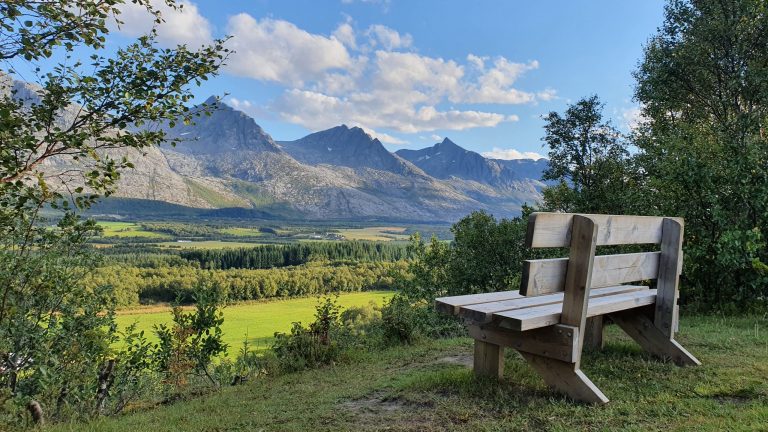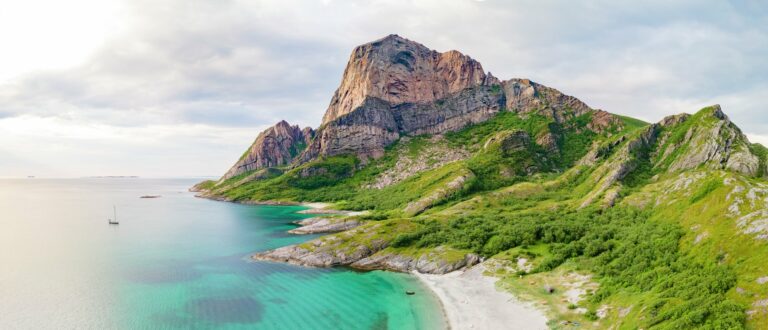There are thousands of mountains in Helgeland, some more distinctive than others. A few have been important landmarks for seafarers since time immemorial. Some of the mountains are mentioned in the legend of the Seven Sisters. Other mountains just look like they emerged from a fairytale.
The Seven Sisters
Seven steep peaks overlook the town of Sandnessjøen. Each of them is about 1000 metres high, with summits that enjoy mighty views of the Helgeland coast. These mountaintops are amongst our best natural attractions and they are popular hiking destinations.
There are simple marked trails to each peak, as well as between the peaks. If you are in decent physical shape, you might choose a hiking trip to one or two of the peaks. Some hikers insist on ascending all seven peaks in a single day! That, however, is an immense endurance test that requires serious planning and considerable experience and physical training.
Torghatten
Torghatten is a distinctive hat-shaped mountain, famous for having a large hole through it. According to legend, the hole was created when the Sulis Troll-King threw his hat into the air to deflect an arrow fired at the Maiden of Leka by the enraged Horseman who was chasing her. Just as the arrow pierced the hat, the sun rose and all were turned to stone. (Actually the 75 metre high hole was probably carved by ice and water during the last ice age.)
The walk up the mountain and through the famous hole is surprisingly easy, making it perfect for the whole family. The hike takes about an hour.
Rødøyløva
Rødøyøva (“the lion of Rødøy”) rises proudly above the rest of the island and, although its height is a modest 443 metres, the view from the summit is impressive. The summit hike is quite easy, with stone steps most of the way. However, hikers should be aware that there are some steep sections, and that one side of the unsecured summit peers down a precipitous cliff.
Please be cautious, tread carefully, obey the Norwegian Mountain Code – and enjoy the great view!
Hestmannen – the Horseman
The Horseman is the villain in the Legend of the Seven Sisters, and the mountain named after him does indeed resemble a cloaked rider. According to legend, while the Horseman chased the Maiden of Leka down the Helgeland coast, the first rays of the sun struck him and he turned to stone.
The island on which the mountain sits has several Norwegian names: Hestmannøy, Hestmona and Storselsøy. You can reach the island by taking the express boat or ferry from Tonnes, Jektvik or Rødøya.
Trænstaven and Trænafjellene
The mountains of Træna rise abruptly from the sea, surrounded by sea and far beyond the Helgeland coast. The highest of its mountains is Trænstaven – it looks like a giant despite being only 338 metres high. All the same, this mountain is extremely steep, almost vertical, and an ascent should not be attempted without rock-climbing equipment and an experienced guide.
Instead, we recommend a walk up the road to Gompen radar station.
 Terje Rakke, Nordic Life / Visit Helgeland
Terje Rakke, Nordic Life / Visit Helgeland
Lovundfjellet and the puffin kingdom
Lovundfjellet, which rises in solitary majesty from the sea, is significantly higher than the mountains of Træna. On a clear day, the 623-metre summit enjoys a magnificent view over the entire Helgeland coast. As for most of the mountains on the Helgeland coast, the trail to the top is simple and unsecured, but without the convenience of constructed stone stairs. Always check the weather forecast and seek the advice of locals before you embark on a summit hike. Even if you don’t make it to the top, Lovundfjellet’s beauty can be enjoyed even from the surrounding lowlands.
By the way: Lovund is home to one of Norway’s largest puffin colonies. Up to 300,000 of the curious-looking seabirds nest here each year. Read more about birdwatching here.






